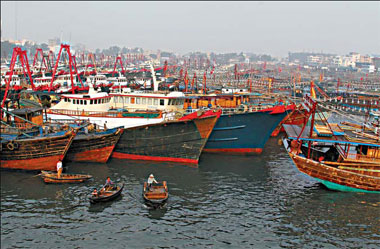Guangxi enjoys tighting business ties with neighbors
Updated: 2007-12-24 17:33
The largest project to date is from Wuhan Iron and Steel (Group) Corp (WISC) for a 60 billion yuan production facility to be operated in conjunction with regional government. If finished on schedule in 2008, its annual steel output is projected to be 30 million tons.
Based on current prices, the WISC project may generate a total revenue of 300 billion yuan a year, more than 60 percent of the city's total industrial output value in 2006, Lei says. The benefit to WISC will be enormous savings on transportation.
Exciting to locals are prospects that the WISC project may create as much as 25 billion yuan in new opportunities for supporting business. "Fangchenggang's econ-omy will then begin a process of exponential growth," Lei says.
Oil hub
Not far off, another Guangxi port city, Qinzhou, will be the site for a refinery operated by China National Petroleum Corporation (CNPC), the largest State-owned oil and refinery group.

CNPC announced a 15.2 billion yuan plan earlier this year for its first plant in southern China. Completion is also set for 2008, when the new refinery will begin to produce annual output worth 40 billion yuan, one and half times the city's present industrial value.
CNPC has been trying to expand its market share in western China, but to do so it must import crude oil for its refinery in northeastern China and then transport fuel to the distant region.
But soon the company's Qinzhou refinery will use crude imported by sea from Vietnam and Indonesia and then supply not only Guangxi, but also Sichuan and Yunnan by road and rail.
When implemented, the network will save CNPC at least 200 yuan a ton on transportation costs, says Wu Enlai, general manager of CNPC Guangxi.
Politics and business
All that Guangxi had to do to reap the benefits was to make an overture to the PBGSEC, which is a framework in which nations work with nations. It has neither a regional strategy nor intention to go around the sovereignty of any nation in Southeast Asia, China Business Weekly learned from a Ministry of Commerce official.
As urged by Premier Wen Jiabao, an expert panel - nine Chinese and seven from the other six nations - completed a feasibility study of the PBGSEC in July, when they recommended an early start to the project.
The effort comes after a China-ASEAN free trade area, the first of its kind in China, was proposed in 2002. The FTA is expected to officially take effect in 2010, when tariffs on more than 90 percent of exports and imports from the 11 nations involved fall to almost zero while mutual trade is projected to reach $200 billion.
ASEAN and China are each other's fourth-largest trade partners, reaching a combined $160.8 billion last year. Experts predict the figure will climb to $180 billion this year.
"Closer cooperation within PBGSEC will be good for the sustainable development of China-ASEAN economic relations," says Zhai Kun, director of Southeast Asian and Oceanic Studies under the China Institute of Contemporary International Relations and a member of the feasibility study team.
A new expert panel will work out a roadmap to reach the PBGSEC goals. Li Guanghui, a senior researcher at the Chinese Academy of International Trade and Economic Cooperation at the Ministry of Commerce, tells China Business Weekly the Chinese team was formed in October and foreign participants will be set early next year.
In preparation for future trade, the Guangxi Beibu Gulf Port Group was founded last February to coordinate the three Chinese ports in doing business with neighboring Vietnam.
The local government also announced a 100 billion yuan investment plan for building and renovating expressways and railways to better connect Guangxi with Vietnam and adjacent provinces in China.
|
|

